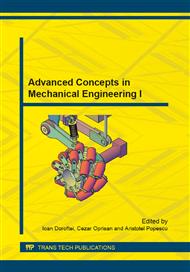p.377
p.381
p.389
p.395
p.401
p.407
p.413
p.417
p.423
Modeling of the Seated Human Body in a Vibrational Medium
Abstract:
Vibrations are mechanical oscillations produced by regular or irregular period movements of a member or body about its rest position. Vibration can affect visual perception, muscles, concentration, circulation and the respiratory system and at certain levels can even result in physical harm to the body. The effect of vibration on the human body is related to the natural frequency of parts of the human body affected. This paper studies the dynamic characteristics of a seated human body system in a vibration environment. The main result is a multi degrees of freedom lumped parameter model. The model provided an analytical tool for human body dynamics research. It also enabled a primary tool for seat and cushioning design. Combining the geometry and the mechanical characteristics of a structure under large deformation into a lumped parameter model enables successful analysis of the human/seat interface system and provides practical results for body protection in dynamic environment. The relative displacements of human parts are evaluated, which can be a basis for the assessment of vibration risk. It is suggested that the multi-body dynamic model is used to evaluate the vibration effect to the seated subjects.
Info:
Periodical:
Pages:
401-406
Citation:
Online since:
October 2014
Authors:
Keywords:
Price:
Сopyright:
© 2014 Trans Tech Publications Ltd. All Rights Reserved
Share:
Citation:


